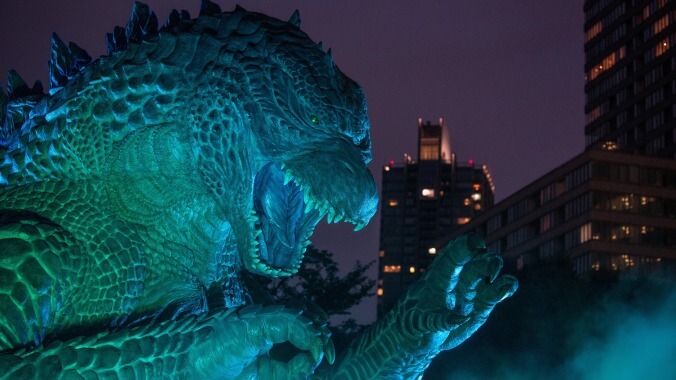Why Godzilla plays so differently in America and Japan
Godzilla Minus One and Monarch: Legacy Of Monsters demonstrate the clearly distinct approaches to the storied character

Some of the best moments of the new Apple TV+ series Monarch: Legacy Of Monsters happen when Godzilla shows up, even when it’s just a reminder that he exists somewhere in that world, the same one depicted in the MonsterVerse movies produced by Legendary. It’s similar to the thrill when one of the Avengers stops by for a cameo on a Marvel show, making the whole thing seem bigger and more exciting thanks to its association with a character from the movies. In the case of Monarch, though, that character just happens to be Godzilla, rather than James Rhodes or whoever.
While Godzilla has always been an icon in his home country of Japan—where he’s seen as a sort of city-smashing, radiation-blasting Mickey Mouse—the two most recent Godzilla movies from Japan (2016’s Shin Godzilla and the brand new Godzilla Minus One) have taken a somewhat different approach to their depiction of him. For one thing: He’s a monster.
Monarch and the recent American movies (the 2014 Godzilla, 2019’s Godzilla: King Of Monsters, and 2021’s Godzilla Vs. Kong) are largely about the awe-inspiring majesty of Godzilla, with humanity just politely stepping out of the way so he can battle whatever other big monster he needs to battle—to the point where it’s almost a novelty that a character in Monarch suffers from Godzilla PTSD. Everyone else has just more or less accepted that mankind shares the planet with these “Titans” (as they’re called in that canon), and they do their best to live their lives with that knowledge.
In Japan, though, Godzilla has always had more metaphorical depth, for one wholly unsurprising reason. The original 1954 Godzilla movie famously presents the monster as both a retribution for mankind’s use of the atomic bomb (since he was created by radioactive energy) and a physical embodiment of the destruction caused by the bombs.
Shin Godzilla, written and co-directed by Neon Genesis Evangelion creator Hideaki Anno (a man who is no stranger to metaphors upon metaphors), adds another chilling wrinkle to the nuclear war imagery by introducing Godzilla as a natural disaster akin to the 2011 earthquake and tsunami that triggered the Fukushima nuclear accident. In the film, Godzilla first makes landfall as a (relatively) small lizard creature, scuttling through the water and carrying discarded boats and chunks of bridges like debris in a tidal wave, all while the government hems and haws about how to respond with meetings upon meetings upon meetings (and the United States refuses to help).
Some of Toho’s Godzilla movies have made the main guy cute or funny, and he’s just kind of a badass in the MonsterVerse movies (where he’s a metaphor for “monsters are cool”), but Shin Godzilla’s monster is horrific. This isn’t a fun, misunderstood guy that Millie Bobby Brown would sympathize with (like in King Of The Monsters), this is a disgusting, mutated beast that exists only to kill—a physical embodiment of death and destruction, like a natural disaster, or the radioactive fallout from a power plant that got hit by a natural disaster. In short, if there were a Monarch-style TV show set in the world of Shin Godzilla, where regular people go about their lives in a world where Godzilla exists, it would not be fun when he shows up. It would be terrifying.
The same goes for Godzilla Minus One, a period piece pointedly set in post-World War II Japan where the big guy is once again awoken/created by American nuclear bomb tests. Visually, he’s not quite the unnerving creature of Shin Godzilla, which looks like the twisted result of mankind’s hubristic devastation of the environment, but he’s also not the huggable, friend-shaped lizard that everyone wanted Kong to kiss in the last American movie. (Don’t deny that you’d want to give Current American Godzilla a hug if your arms were big enough.)
Minus One, notably, is also the first Godzilla movie to come out in the wake of another disaster, this one the global COVID-19 pandemic. Shin Godzilla poked a lot of fun at government bureaucracy (there’s one sequence where a meeting is interrupted by the need for a second meeting about the first meeting, and then everyone goes back and continues the first meeting), but people all over the world now have seen what happens in real life when under-prepared governments are unable or unwilling to react to a massive threat. COVID doesn’t look like Godzilla just like radiation doesn’t look like Godzilla, but that’s part of the lasting power of the character in Japan: There are a lot of unfathomably large things to be scared of in the world, and it helps to put a big face and tail and dorsal plates on it.
None of this is to say that the MonsterVerse movies are bad, or even a misinterpretation of the character. They serve different audiences and have different goals. Knowing Americans and American audiences, “this monster represents a bad thing that some people pretend doesn’t exist anyway” is a tougher sell than “this monster represents monsters.” It’s a more basic fun, but it is also, arguably, more fun. And, in a very rare instance over Godzilla’s nearly seven-decade history, you can experience both interpretations this weekend with Godzilla Minus One in theaters and a new episode of Monarch on Apple TV+.